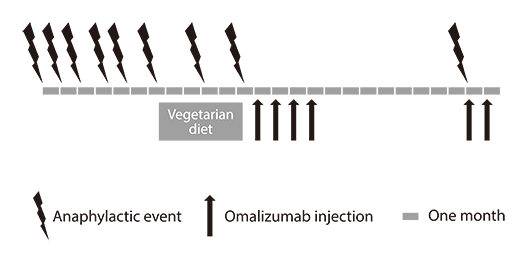Asia Pac Allergy.
2014 Apr;4(2):126-128. 10.5415/apallergy.2014.4.2.126.
Successful prevention of recurrent anaphylactic events with anti-immunoglobulin E therapy
- Affiliations
-
- 1Department of Internal Medicine, Jeju National University School of Medicine, Jeju 690-756, Korea. doc4u@hanmail.net
- KMID: 2397116
- DOI: http://doi.org/10.5415/apallergy.2014.4.2.126
Abstract
- Anaphylaxis is a fatal and systemic allergic reaction, which can be prevented by avoiding exposure to a causative agent. However, the causative agent cannot be identified in all cases and may be hardly avoided. A 41-year-old man, diagnosed with idiopathic anaphylaxis, experienced 6 anaphylactic events over 7 months, requiring 4 emergency department (ER) visits and 3 epinephrine self-injections. Anti-immunoglobulin E (IgE) therapy was introduced to prevent further anaphylactic events. He experienced no anaphylactic events during 13 months of 4 monthly injections from the beginning until his most recent ER visit because of a similar anaphylactic event. We report a patient who experienced recurrent anaphylactic events that were prevented effectively by anti-IgE therapy with omalizumab. Anti-IgE therapy might be considered as an option to prevent anaphylactic events in patients for whom the causative agent(s) cannot be identified or avoided.
Keyword
MeSH Terms
Figure
Reference
-
1. Simons FE, Ardusso LR, Bilo MB, Dimov V, Ebisawa M, El-Gamal YM, Ledford DK, Lockey RF, Ring J, Sanchez-Borges M, Senna GE, Sheikh A, Thong BY, Worm M. World Allergy Organization. 2012 Update: World Allergy Organization Guidelines for the assessment and management of anaphylaxis. Curr Opin Allergy Clin Immunol. 2012; 12:389–399.2. Webb LM, Lieberman P. Anaphylaxis: a review of 601 cases. Ann Allergy Asthma Immunol. 2006; 97:39–43.
Article3. Nam YH, Kim JH, Jin HJ, Hwang EK, Shin YS, Ye YM, Park HS. Effects of omalizumab treatment in patients with refractory chronic urticaria. Allergy Asthma Immunol Res. 2012; 4:357–361.
Article4. Kaplan AP. Treatment of chronic spontaneous urticaria. Allergy Asthma Immunol Res. 2012; 4:326–331.
Article5. Lieberman JA, Chehade M. Use of omalizumab in the treatment of food allergy and anaphylaxis. Curr Allergy Asthma Rep. 2013; 13:78–84.
Article6. Nam YH, Lee SK. Management of severe refractory asthma. Korean J Med. 2012; 83:438–443.
Article7. Lee J, Doggweiler-Wiygul R, Kim S, Hill BD, Yoo TJ. Is interstitial cystitis an allergic disorder?: A case of interstitial cystitis treated successfully with anti-IgE. Int J Urol. 2006; 13:631–634.
Article8. Kontou-Fili K, Filis CI. Prolonged high-dose omalizumab is required to control reactions to venom immunotherapy in mastocytosis. Allergy. 2009; 64:1384–1385.
Article9. Sicherer SH, Leung DY. Advances in allergic skin disease, anaphylaxis, and hypersensitivity reactions to foods, drugs, and insects in 2009. J Allergy Clin Immunol. 2010; 125:85–97.
Article10. Jaqua NT, Peterson MR, Davis KL. Exercise-induced anaphylaxis: a case report and review of the diagnosis and treatment of a rare but potentially life-threatening syndrome. Case Rep Med. 2013; 2013:610726.
Article11. Jones JD, Marney SR Jr, Fahrenholz JM. Idiopathic anaphylaxis successfully treated with omalizumab. Ann Allergy Asthma Immunol. 2008; 101:550–551.
Article12. Warrier P, Casale TB. Omalizumab in idiopathic anaphylaxis. Ann Allergy Asthma Immunol. 2009; 102:257–258.
Article13. Pitt TJ, Cisneros N, Kalicinsky C, Becker AB. Successful treatment of idiopathic anaphylaxis in an adolescent. J Allergy Clin Immunol. 2010; 126:415–416. author reply 416.
Article14. Bell MC, Jackson DJ. Prevention of anaphylaxis related to mast cell activation syndrome with omalizumab. Ann Allergy Asthma Immunol. 2012; 108:383–384.
Article
- Full Text Links
- Actions
-
Cited
- CITED
-
- Close
- Share
- Similar articles
-
- Clinical Efficacy of Intravenous Immunoglobulin for the Prevention of Recurrent Spontaneous Abortion
- Inhibition of IgE-mediated anaphylactic reaction by Mentha arvensis in rats
- A Case of Successful Pregnancy in a Woman with Anti-M Isoimmunization after Intravenous Immunoglobulin Therapy
- A Case of Anaphylaxis due to Repeated Intradermal Testing with Ampicillin
- A Case of Immunoglobulin Deficiency with increased IgM


